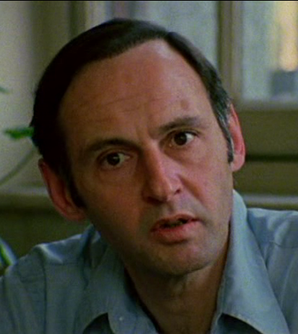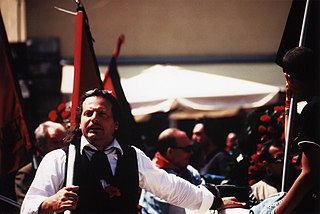Related Research Articles
John Moore was a British anarchist author, teacher, and organiser.

Albert Isidore Meltzer was an English anarcho-communist activist and writer.

Anarchism in the United Kingdom initially developed within the religious dissent movement that began after the Protestant Reformation. Anarchism was first seen among the radical republican elements of the English Civil War and following the Stuart Restoration grew within the fringes of radical Whiggery. The Whig politician Edmund Burke was the first to expound anarchist ideas, which developed as a tendency that influenced the political philosophy of William Godwin, who became the first modern proponent of anarchism with the release of his 1793 book Enquiry Concerning Political Justice.

Paul Avrich was a historian of the 19th and early 20th century anarchist movement in Russia and the United States. He taught at Queens College, City University of New York, for his entire career, from 1961 to his retirement as distinguished professor of history in 1999. He wrote ten books, mostly about anarchism, including topics such as the 1886 Haymarket Riot, 1921 Sacco and Vanzetti case, 1921 Kronstadt naval base rebellion, and an oral history of the movement.

Jean Grave was an important activist in the French anarchist and the international anarchist communism movements. He was the editor of three major anarchist periodicals, Le Révolté, La Révolte and Les Temps Nouveaux, and wrote dozens of pamphlets and a number of important anarchist books.
Miguel García García (1908–1981) was a Spanish anarchist and writer. He was a political prisoner during the Franco era.

The Kate Sharpley Library is a library dedicated to anarchist texts and history. Started in 1979 and reorganized in 1991, it currently holds around ten thousand English language volumes, pamphlets and periodicals.

Abel Paz (1921–2009) was a Spanish anarchist and historian who fought in the Spanish Civil War. He is considered one of the noted Spanish anarchist historians, writing multiple volumes on anarchist history, including a biography of Buenaventura Durruti, an influential anarchist during the war. He kept the anarchist tradition throughout his life, including a decade in Francoist Spain's jails and multiple decades in exile in France.

Anarchism in France can trace its roots to thinker Pierre-Joseph Proudhon, who grew up during the Restoration and was the first self-described anarchist. French anarchists fought in the Spanish Civil War as volunteers in the International Brigades. According to journalist Brian Doherty, "The number of people who subscribed to the anarchist movement's many publications was in the tens of thousands in France alone."

Joseph Albert was an individualist anarchist militant and writer from France who edited the influential anarchist publication L'Anarchie.

Anselme Bellegarrigue was a French individualist anarchist. He participated in the French Revolution of 1848, was author and editor of Anarchie, Journal de l'Ordre and Au fait ! Au fait ! Interprétation de l'idée démocratique.
The following outline is provided as an overview of and topical guide to anarchism:
The Manifesto of the Sixteen, or Proclamation of the Sixteen, was a document drafted in 1916 by eminent anarchists Peter Kropotkin and Jean Grave which advocated an Allied victory over Germany and the Central Powers during the First World War. At the outbreak of the war, Kropotkin and other anarchist supporters of the Allied cause advocated their position in the pages of the Freedom newspaper, provoking sharply critical responses. As the war continued, anarchists across Europe campaigned in anti-war movements and wrote denunciations of the war in pamphlets and statements, including one February 1916 statement signed by prominent anarchists such as Emma Goldman and Rudolf Rocker.
Anarchism: A Documentary History of Libertarian Ideas is a three-volume anthology of anarchist writings edited by historian Robert Graham. The anthology is published by Black Rose Books. Each selection is introduced by Graham, placing each author and selection in their historical and ideological context. The focus of the anthology is on the origins and development of anarchist ideas; it is not a documentary history of the world's anarchist movements, although the selections are geographically diverse.

Alexei Alexeyevich Borovoi (1875–1935) was a Russian individualist anarchist writer, orator, teacher and propagandist.

121 Centre was a squatted self-managed social centre on Railton Road in Brixton, south London from 1981 until 1999. As an anarchist social centre, the venue hosted a bookshop, cafe, infoshop, library, meeting space, office space, printing facility, and rehearsal space. Organisations using the space included Food Not Bombs, Anarchist Black Cross prisoner aid chapters, an anarcho-feminist magazine, a squatters aid organisation, and an anarchist queer group. Regular events at 121 Centre included punk concerts, a women's cafe night, and a monthly queer night. The centre kept a low profile and was one of the longest-lasting squats in London.
Anarchist archives preserve records from the international anarchist movement in personal and institutional collections around the world. This primary source documentation is made available for researchers to learn directly from movement anarchists, both their ideas and lives.
La Société mourante et l'anarchie, translated as Moribund Society and Anarchy, is an 1893 book by Jean Grave that argues for the speedy disintegration of moribund societal institutions.
Anarchism in Hungary emerged from the social democratic movement in the late 19th century, coming to play a prominent role in the anti-militarist movement during World War I and in the subsequent revolution that culminated in the Hungarian Soviet Republic. The anarchist movement was then repressed by the Horthy regime, before re-emerging as part of the anti-fascist resistance movement during World War II. This second wave of anarchism was also repressed, this time by the newly established communist regime. Anarchist ideas were briefly expressed during the Hungarian Revolution of 1956 but remained largely suppressed until the fall of socialism, which gave way to a third wave of anarchism in Hungary.
References
- ↑ Introduction of the 2002 Kate Sharpley Library edition by Sharif Gemie, editor of Anarchist Studies .
- ↑ Nettlau, Max (1996). A Short History of Anarchism, trans. Ida Pilat Isca, ed. Heiner M. Becker (London: Freedom Press). Excerpt from the Molinari Institute.